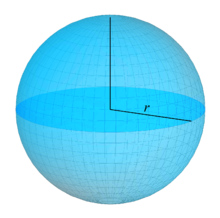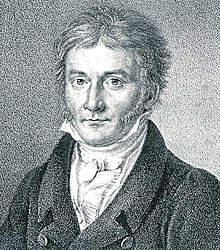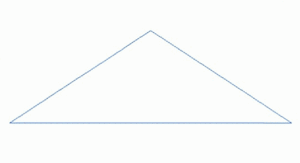Surface (mathematics)
This article needs additional citations for verification. (February 2022) |

In
There are several more precise definitions, depending on the context and the mathematical tools that are used for the study. The simplest mathematical surfaces are planes and
A surface is a
Definitions
Often, a surface is defined by
A surface may also be defined as the image, in some space of dimension at least 3, of a continuous function of two variables (some further conditions are required to insure that the image is not a curve). In this case, one says that one has a parametric surface, which is parametrized by these two variables, called parameters. For example, the unit sphere may be parametrized by the Euler angles, also called longitude u and latitude v by
Parametric equations of surfaces are often irregular at some points. For example, all but two points of the unit sphere, are the image, by the above parametrization, of exactly one pair of Euler angles (
In
Terminology
There are several kinds of surfaces that are considered in mathematics. An unambiguous terminology is thus necessary to distinguish them when needed. A
A "surface" is often implicitly supposed to be contained in a
Examples
- The open subset of R2 is a topological surface. If the function is differentiable, the graph is a differentiable surface.
- A plane is both an algebraic surface and a differentiable surface. It is also a ruled surface and a surface of revolution.
- A circular cylinder (that is, the locusof a line crossing a circle and parallel to a given direction) is an algebraic surface and a differentiable surface.
- A circular cone (locus of a line crossing a circle, and passing through a fixed point, the apex, which is outside the plane of the circle) is an algebraic surface which is not a differentiable surface. If one removes the apex, the remainder of the cone is the union of two differentiable surfaces.
- The surface of a polyhedron is a topological surface, which is neither a differentiable surface nor an algebraic surface.
- A hyperbolic paraboloid (the graph of the function z = xy) is a differentiable surface and an algebraic surface. It is also a ruled surface, and, for this reason, is often used in architecture.
- A two-sheet hyperboloidis an algebraic surface and the union of two non-intersecting differentiable surfaces.
Parametric surface
A parametric surface is the image of an open subset of the Euclidean plane (typically ) by a
Specifically, a parametric surface in is given by three functions of two variables u and v, called parameters
As the image of such a function may be a
has
Tangent plane and normal vector
A point p where the above Jacobian matrix has rank two is called regular, or, more properly, the parametrization is called regular at p.
The
The
For other differential invariants of surfaces, in the neighborhood of a point, see Differential geometry of surfaces.
Irregular point and singular point
A point of a parametric surface which is not regular is irregular. There are several kinds of irregular points.
It may occur that an irregular point becomes regular, if one changes the parametrization. This is the case of the poles in the parametrization of the
On the other hand, consider the
The apex of the cone is the origin (0, 0, 0), and is obtained for t = 0. It is an irregular point that remains irregular, whichever parametrization is chosen (otherwise, there would exist a unique tangent plane). Such an irregular point, where the tangent plane is undefined, is said singular.
There is another kind of singular points. There are the self-crossing points, that is the points where the surface crosses itself. In other words, these are the points which are obtained for (at least) two different values of the parameters.
Graph of a bivariate function
Let z = f(x, y) be a function of two real variables. This is a parametric surface, parametrized as
Every point of this surface is regular, as the two first columns of the Jacobian matrix form the identity matrix of rank two.
Rational surface
A rational surface is a surface that may be parametrized by
in two indeterminates, then the parametric surface, defined byis a rational surface.
A rational surface is an algebraic surface, but most algebraic surfaces are not rational.
Implicit surface
An implicit surface in a Euclidean space (or, more generally, in an affine space) of dimension 3 is the set of the common zeros of a differentiable function of three variables
Implicit means that the equation defines implicitly one of the variables as a function of the other variables. This is made more exact by the implicit function theorem: if f(x0, y0, z0) = 0, and the partial derivative in z of f is not zero at (x0, y0, z0), then there exists a differentiable function φ(x, y) such that
in a neighbourhood of (x0, y0, z0). In other words, the implicit surface is the graph of a function near a point of the surface where the partial derivative in z is nonzero. An implicit surface has thus, locally, a parametric representation, except at the points of the surface where the three partial derivatives are zero.
Regular points and tangent plane
A point of the surface where at least one partial derivative of f is nonzero is called regular. At such a point , the tangent plane and the direction of the normal are well defined, and may be deduced, with the implicit function theorem from the definition given above, in § Tangent plane and normal vector. The direction of the normal is the gradient, that is the vector
The tangent plane is defined by its implicit equation
Singular point
A singular point of an implicit surface (in ) is a point of the surface where the implicit equation holds and the three partial derivatives of its defining function are all zero. Therefore, the singular points are the solutions of a
The study of surfaces near their singular points and the classification of the singular points is singularity theory. A singular point is isolated if there is no other singular point in a neighborhood of it. Otherwise, the singular points may form a curve. This is in particular the case for self-crossing surfaces.
Algebraic surface
Originally, an algebraic surface was a surface which may be defined by an implicit equation
where f is a polynomial in three indeterminates, with real coefficients.
The concept has been extended in several directions, by defining surfaces over arbitrary fields, and by considering surfaces in spaces of arbitrary dimension or in projective spaces. Abstract algebraic surfaces, which are not explicitly embedded in another space, are also considered.
Surfaces over arbitrary fields
Polynomials with coefficients in any field are accepted for defining an algebraic surface. However, the field of coefficients of a polynomial is not well defined, as, for example, a polynomial with rational coefficients may also be considered as a polynomial with real or complex coefficients. Therefore, the concept of point of the surface has been generalized in the following way.[2][page needed]
Given a polynomial f(x, y, z), let k be the smallest field containing the coefficients, and K be an
If the polynomial has real coefficients, the field K is the
Projective surface
A projective surface in a projective space of dimension three is the set of points whose homogeneous coordinates are zeros of a single homogeneous polynomial in four variables. More generally, a projective surface is a subset of a projective space, which is a projective variety of dimension two.
Projective surfaces are strongly related to affine surfaces (that is, ordinary algebraic surfaces). One passes from a projective surface to the corresponding affine surface by setting to one some coordinate or indeterminate of the defining polynomials (usually the last one). Conversely, one passes from an affine surface to its associated projective surface (called projective completion) by homogenizing the defining polynomial (in case of surfaces in a space of dimension three), or by homogenizing all polynomials of the defining ideal (for surfaces in a space of higher dimension).
In higher dimensional spaces
One cannot define the concept of an algebraic surface in a space of dimension higher than three without a general definition of an algebraic variety and of the dimension of an algebraic variety. In fact, an algebraic surface is an algebraic variety of dimension two.
More precisely, an algebraic surface in a space of dimension n is the set of the common zeros of at least n – 2 polynomials, but these polynomials must satisfy further conditions that may be not immediate to verify. Firstly, the polynomials must not define a variety or an
Most authors consider as an algebraic surface only algebraic varieties of dimension two, but some also consider as surfaces all algebraic sets whose irreducible components have the dimension two.
In the case of surfaces in a space of dimension three, every surface is a complete intersection, and a surface is defined by a single polynomial, which is irreducible or not, depending on whether non-irreducible algebraic sets of dimension two are considered as surfaces or not.
Topological surface
In
Every topological surface is homeomorphic to a
The homeomorphism classes of surfaces have been completely described (see Surface (topology)).
Differentiable surface

In
Fractal surface

A fractal landscape or fractal surface is generated using a stochastic algorithm designed to produce fractal behavior that mimics the appearance of natural terrain. In other words, the surface resulting from the procedure is not a deterministic, but rather a random surface that exhibits fractal behavior.[5]
Many natural phenomena exhibit some form of statistical
Because the intended result of the process is to produce a landscape, rather than a mathematical function, processes are frequently applied to such landscapes that may affect the stationarity and even the overall fractal behavior of such a surface, in the interests of producing a more convincing landscape.
According toIn computer graphics

See also
- Area element, the area of a differential element of a surface
- Coordinate surfaces
- Hypersurface
- Perimeter, a two-dimensional equivalent
- Polyhedral surface
- Shape
- Signed distance function
- Solid figure
- Surface area
- Surface patch
- Surface integral
Notes
- implicit equation".
- ]
- ^ The infinite degree of transcendence is a technical condition, which allows an accurate definition of the concept of generic point.
- ^ Gauss 1902.
- ^ "The Fractal Geometry of Nature".
- ISBN 3-540-69428-5 page [1]
- ISBN 0-8058-4395-7 pages 173–177 [2]
- ISBN 981-02-0720-4 page 45 [3]
- ISBN 0-674-00772-7 pages 351–359 [4]
- ISBN 978-0671742171. Retrieved 15 June 2014.
Sources
Gauss, Carl Friedrich (1902), General Investigations of Curved Surfaces of 1825 and 1827, Princeton University Library





![{\displaystyle {\begin{aligned}x&=f_{1}(u,v),\\[4pt]y&=f_{2}(u,v),\\[4pt]z&=f_{3}(u,v)\,.\end{aligned}}}](https://wikimedia.org/api/rest_v1/media/math/render/svg/f8946cd2573c372525b0dec0e79413ba390f32f8)
![{\displaystyle {\begin{bmatrix}{\dfrac {\partial f_{1}}{\partial u}}&{\dfrac {\partial f_{1}}{\partial v}}\\[6pt]{\dfrac {\partial f_{2}}{\partial u}}&{\dfrac {\partial f_{2}}{\partial v}}\\[6pt]{\dfrac {\partial f_{3}}{\partial u}}&{\dfrac {\partial f_{3}}{\partial v}}\end{bmatrix}}}](https://wikimedia.org/api/rest_v1/media/math/render/svg/ef0d2b93d2507124b250c42e721a277064a9f845)


![{\displaystyle {\begin{aligned}x&={\frac {f_{1}(t,u)}{f_{0}(t,u)}},\\[6pt]y&={\frac {f_{2}(t,u)}{f_{0}(t,u)}},\\[6pt]z&={\frac {f_{3}(t,u)}{f_{0}(t,u)}}\,,\end{aligned}}}](https://wikimedia.org/api/rest_v1/media/math/render/svg/5c01e381d880542b94aba3160c5d11c339b46e15)



![{\displaystyle \left[{\frac {\partial f}{\partial x}}(x_{0},y_{0},z_{0}),{\frac {\partial f}{\partial y}}(x_{0},y_{0},z_{0}),{\frac {\partial f}{\partial z}}(x_{0},y_{0},z_{0})\right].}](https://wikimedia.org/api/rest_v1/media/math/render/svg/9b93753ba36c47db43d602f08750ff6c02d8d208)

